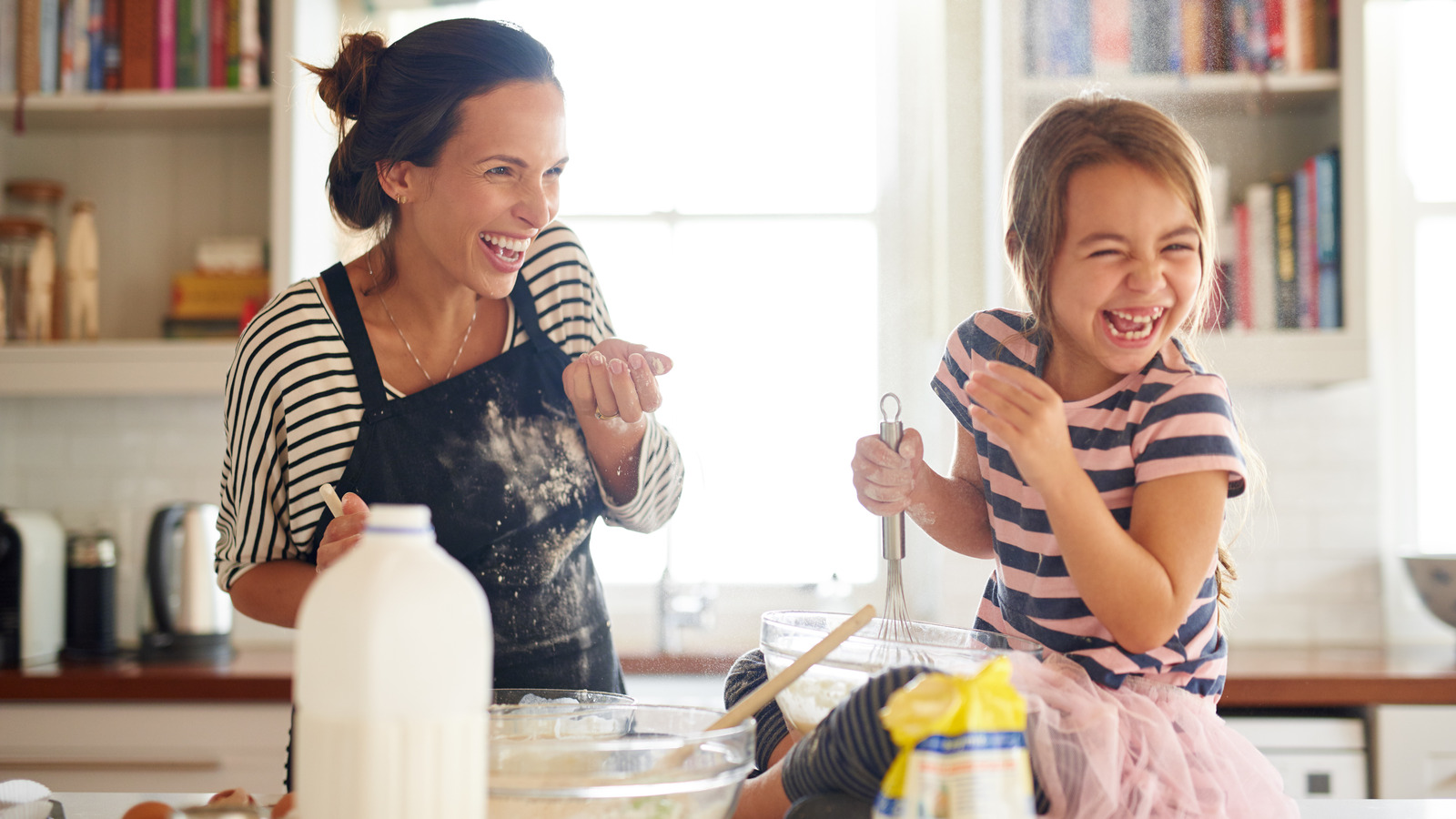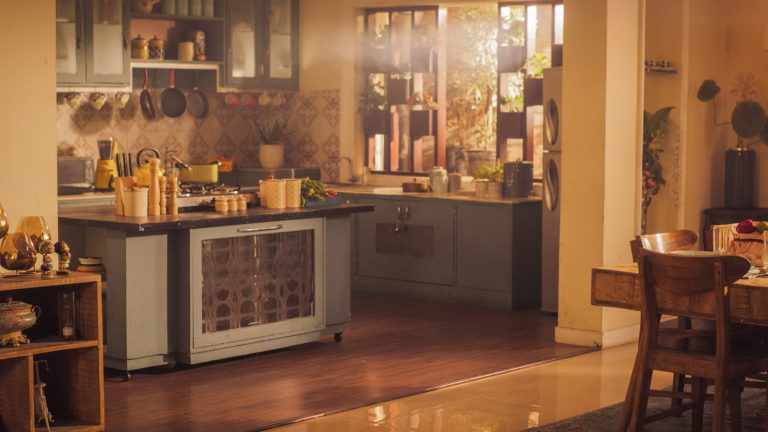We may receive a commission on purchases made from links.
If you have children, you may be wondering when you should start teaching them how to cook. You want to make sure they grow up to be independent in the kitchen, but you also don’t want to jump the gun and expect too much of them too early. Plus, many cooking skills have the potential to be dangerous, such as chopping or slicing with a hot knife or carrying a pot of boiling water across the kitchen to drain it in the sink, so you may question the safety of introducing such skills to your kids.
Generally speaking, the earlier you can start involving your children in helping you prepare recipes, the better. Of course, the types of cooking skills that you should teach them will vary by age. A 12-year-old, for example, will be able to safely perform tasks that would be inappropriate for a toddler. Having safe and age-appropriate tools can also help as you start educating your children. Fortunately, there are plenty of great kitchen tools for kids that you could look into purchasing as you decide what you want to focus on.
Ahead, you’ll find a list of some basic cooking skills you can start teaching your children when they are young. We’ve included some general guidelines related to the appropriate age to start teaching these tasks. However, every kid is different. You know your child much better than us, so use your best judgment to determine whether they are ready to safely execute a specific skill.
How to weigh and measure ingredients
Weighing and measuring ingredients is a good skill to start working with your children on from a young age. First, it will start introducing them to numbers and basic math concepts. Measuring involves math. Whether you’re identifying a fraction on a measuring cup or doubling a recipe and using addition, math is an essential skill when cooking and baking.
Beyond starting to develop those early math skills, measuring is also an integral component of making sure a recipe turns out correctly. Too much or too little of an ingredient can be disastrous, so helping your children understand how to avoid that will help them become successful chefs and bakers in the future. It will also be important to start teaching your child that the best ways to measure different baking ingredients aren’t always the same. For example, while you should use a dry measuring cup and level for sugar, weighing flour on the scale is the most accurate. Liquids, on the other hand, should be measured in a liquid measuring cup, instead of one intended for dry ingredients.
How to pour ingredients
Knowing how to weigh and measure ingredients is only the first step in adding them to a recipe. You’ll also want to work with your child on how to add the flour, sugar, cocoa powder, vanilla, and other ingredients to the mixing bowl or pot after they’ve been measured. While this may seem like an unnecessary step, just imagine what could happen if you give your child a measuring cup full of flour and ask them to add it to the mixing bowl when you’re preparing cookies.
If they hold the measuring cup several inches away from the bowl, or don’t line it up properly over the bowl, you’re going to be left with a flour-covered countertop and floor. Plus, you won’t know how much flour actually made it into the bowl, so it could throw off the whole recipe.
To avoid such catastrophes, it is important to teach your children to carefully hold a measuring cup just over the bowl they are pouring into (for both dry and liquid ingredients). If you pour liquids from too high up, they can also splash out of the bowl.
How to mix ingredients
Young children can start helping you as you mix ingredients. Depending on their age, strength, and motor skills, they may be more or less effective at incorporating them together well, but can still be involved with moving a spoon around the bowl. With toddlers, you may want to do a quick pre-mix to get powdered ingredients slightly wet so that they don’t go flying out of the bowl.
As your kids get older, however, spend time working with them on how to combine ingredients effectively to make sure they remain in the mixing bowl. You can also start teaching them how to use a whisk to break down clumps. With supervision, you may also want to introduce your children to a hand mixer — but be sure to go over important safety tips such as never inserting the beaters when the appliance is plugged in and keeping hands away from the bowl when mixing.
How to wash fruits and vegetables
You may also want to start teaching your children how to wash fruits and vegetables from an early age. While this isn’t a complex task, it also can’t be done properly without some instruction. For example, you’ll want to teach children to use cool water — not hot — to avoid damaging the produce or potentially sending bacteria into it instead of rinsing it away.
Another skill to teach younger children is how to scrub harder veggies, such as potatoes and carrots, to effectively remove the dirt and bacteria from the surface. Don’t forget to explain to children why you shouldn’t wash produce before storing it. Help them learn from a young age that berries, cucumbers, and other items may grow moldy or spoil if they’re washed too much ahead of time.
How to crack eggs
Cracking eggs is an essential skill, whether you’re baking a cake or preparing an omelet. So, it is something you might want to start teaching children as young as three or four.
As with other skills, practice makes perfect, so you shouldn’t expect young children to be able to crack an egg without getting any shell into the bowl, too. As you’re working on teaching them all the hacks that will help perfect eggshell cracking, have them practice over a separate bowl. This way, you’ll be able to fish out any shell that inadvertently goes in with the whites and the yolk.
How to make a sandwich
Making a sandwich is a great task to start teaching young children. It doesn’t require many tools and is a task that a child can see through to completion practically all on their own, empowering them to make a meal by themselves.
For adding the mayonnaise, peanut butter, or other condiments, opt for a spreader instead of a knife, and you won’t need to worry about accidental injury. Work with your child on the best way to hold the bread and the spreader to evenly distribute the condiments, and teach them how to layer meats and cheese. You could even work on some counting skills, as they determine how many pieces of meat and cheese to add to their creation.
How to peel vegetables
Peeling vegetables is another essential cooking skill to learn. Whether you’re making soup, preparing a veggie tray, or want to make mashed potatoes, you need to know how to peel veggies — and how to do so safely.
Because of how sharp a vegetable peeler is, this is a skill that you might want to wait a few years to teach your children. Wait until you feel that they are old enough to handle the peeler safely. As you’re working with your son or daughter, teach them how to hold the vegetable in such a way that their fingers won’t get in the way. Also, show them how to practice peeling away from their body to decrease the chances of an accidental injury.
How to follow key food safety rules
Start teaching your children about food safety rules from an early age — and continue to reinforce these rules as they grow older and become more independent in the kitchen. Understanding food safety tips is essential in preventing cross-contamination and keeping everyone in the household early.
One of the most basic rules to teach little ones is the importance of washing your hands before handling food or after working with raw meat, dirty produce, or anything else that may have germs. You could even do an experiment to help them see how bacteria and germs can remain on your hands if you don’t wash properly with soap and warm water.
Sprinkle a few seasonings and some olive oil on their hands to symbolize the bacteria. Then, have them do a quick wash under cold water (the “germs” will still be there). Show how scrubbing with soap and warm water is the only way to truly get rid of these germs and make sure you’re handling food safely.
A few other safety rules you can start introducing include being aware of cross contamination (such as not using tongs that handled raw meat to toss a salad), leaving perishable foods out at room temperature for no more than two hours, checking meat for doneness using a meat thermometer, and washing produce before eating or cooking with it.
How to make a salad
Making salads is a good task for young chefs to learn. You don’t need to cook over a hot stove or use the oven; it’s not necessary to handle raw meat, and it can help get children excited about eating a healthy meal that they help create.
Preparing a salad can also introduce children to a variety of kitchen tools, such as a salad spinner, julienne peeler, grater, tongs, and a whisk (for making homemade dressing). Of course, depending on the age of your child, you will want to closely supervise or assist with some of these tools, such as grating cheese or julienning carrots, to prevent injury.
How to knead and roll out dough
Several recipes call for kneading and/or rolling out dough, so these are two more skills you might want to begin introducing your children to. Have them help you make bread, cinnamon rolls, sugar cookies, or homemade pies as you show ’em the ropes.
Kneading dough is one task that kids are likely to find enjoyable. What’s not to love? It’s just like playing with Play-Doh, but with real ingredients — this is a skill that even toddlers can get in on. Rolling out dough is a bit more complex and requires some muscle, but young children can still help get the process started, while you work with older kids and teach them the tricks to rolling out pie dough evenly.
How to frost cookies or a cake
Learning how to frost cookies and cakes will prepare children to become successful bakers in the future. And, while some of us might see these tasks as ones that don’t require any thought, we’re probably just so used to doing them that they’ve become second nature.
There are actually several skills that kids will need to learn in order to achieve a beautifully frosted cake or cookie. They’ll need to understand how to evenly spread the frosting over the surface, determine how much pressure to use (and what can happen if they apply too much), and work on their technique to help each baked good look as great as it tastes.
How to plan a meal
Meal planning can be challenging. Start working with your kids from a young age to teach them about this important skill that will benefit them for years to come. Getting your kids involved with the meal planning process can also help solve some of those “I don’t like this” complaints you may hear around meal times.
Your expectations should vary based on the age of your children. With very young children, you may want to focus on working together to list some healthy veggies to serve on the side of an entree. Older children could be given more responsibility, such as choosing the main dish and sides, and even checking the pantry and fridge to see which items are on hand and which will need to be purchased. Once your children learn the skills, it could become a regular task for them to plan dinner one night each week.
How to open a can
While pop-tops seem to be on more and more canned goods, there are still plenty of cans that you can’t open by pulling a tab. Start teaching older children how to safely use a can opener so they’ll be able to add canned goods to their recipes, independently make a tuna sandwich, and more.
Remember, the edges of a can lid are often very sharp after opening, so waiting for your son or daughter to be old enough to handle a removed lid safely should be a priority. Even for older kids, you might want to consider a smooth-edge can opener, such as the Gorilla Grip Smooth Edge Manual Can Opener, to minimize the risk of injury.
How to bread chicken and other foods
Breading chicken, pork chops, or zucchini is a task that older children can help with. It’s a relatively simple duty, but one that requires a few steps to be done correctly. For example, you’ll want to teach your child to dredge the item in flour before dipping it in the eggs and breadcrumbs. You can also work with them on the best seasonings to add to the breadcrumbs based on the specific recipe you’re preparing or on how to flatten chicken breasts or thighs before breading them.
Because of the raw meat and/or eggs that you’ll be working with, you might want to wait until your children are a bit older to teach this skill. You want them to understand food safety and how to avoid cross-contamination.
How to set and read a timer
Setting and reading a timer are both great tasks to work on, even with very young children. Not only will they need to know how to set a timer to ensure their recipes are cooked to perfection, but the skills they learn will be helpful in many other areas of their life as well.
For example, they’ll get practice with identifying numbers and watching them count backwards. They can also start building a mental estimate for how much time has passed if they’re regularly setting timers and hearing them go off. They may even transfer the skill of using a timer in the kitchen into helping them in other ways, such as setting a timer to focus on homework or to clean up their rooms.
How to use the microwave and other small appliances
Older and more mature children can also start learning how to operate some of the small appliances in the kitchen. This can empower them to start preparing more basic meals on their own in the microwave or air fryer.
Small kitchen appliances are often user-friendly, but you’ll still want to teach older children basic safety procedures. For example, they’ll need to learn not to turn a blender on without securing the lid first, that plates and bowls can get very hot after heating food in the microwave, and that you shouldn’t put a metal knife or fork into the toaster to try to pull out a slice of bread.
How to safely use a knife
Teaching kids how to use a knife safely is important. If they don’t learn how to hold the knife or how to keep their fingers away from the blade at an early age, unsafe habits could become ingrained and more difficult to unlearn.
Of course, you don’t want to hand your two-year-old your sharpest santoku knife, so opt for very blunt plastic knives to start. To teach proper knife skills to your child, you should also let them start with soft ingredients that the knife will glide through easily, such as kiwis or bananas.
How to read a recipe and use it to create a grocery list
Learning how to read a recipe is another skill that you should start teaching early. Even adults often don’t follow all the tips that can help them read a recipe before cooking — and end up making mistakes that negatively impact the finished product.
Once your child has some basic reading skills, show them the different parts of a recipe, such as the ingredient list and the step-by-step directions. You can discuss how you should use the ingredient list to check for what you already have and what you’ll need to add to the grocery list.
When discussing how to read the recipe, be sure to stress the importance of reading through the whole thing before you get started. This will give you a preview of what you need to do and the cooking tools you should pull out; it can also prevent those unwanted “surprises” when something is supposed to rest or be refrigerated for several hours and ends up throwing off your timing.





